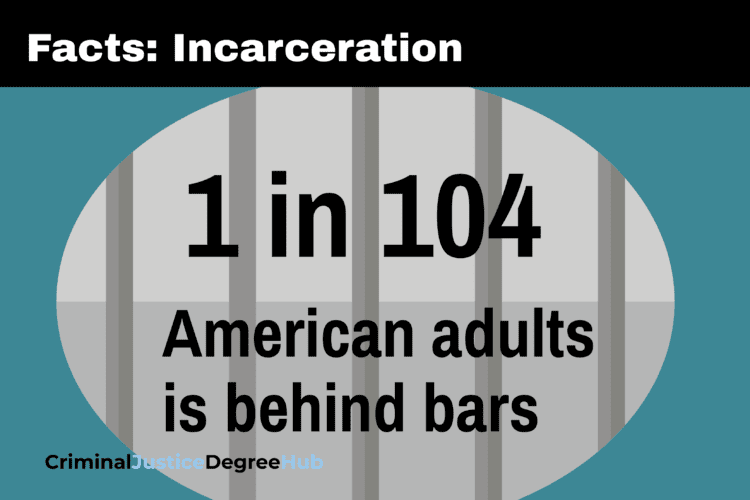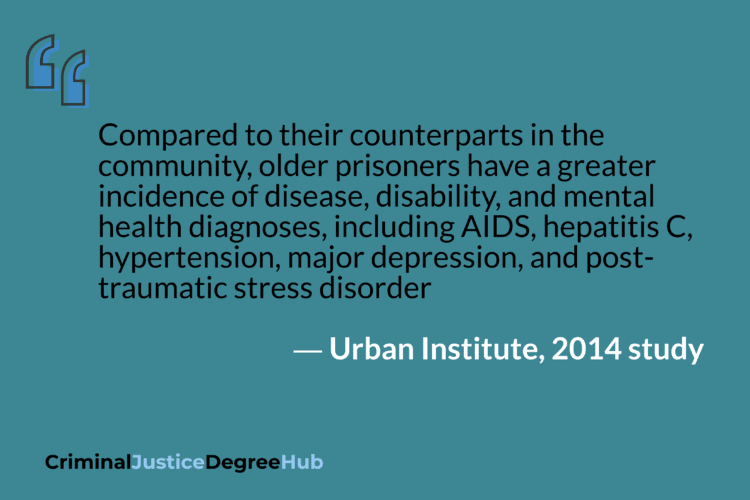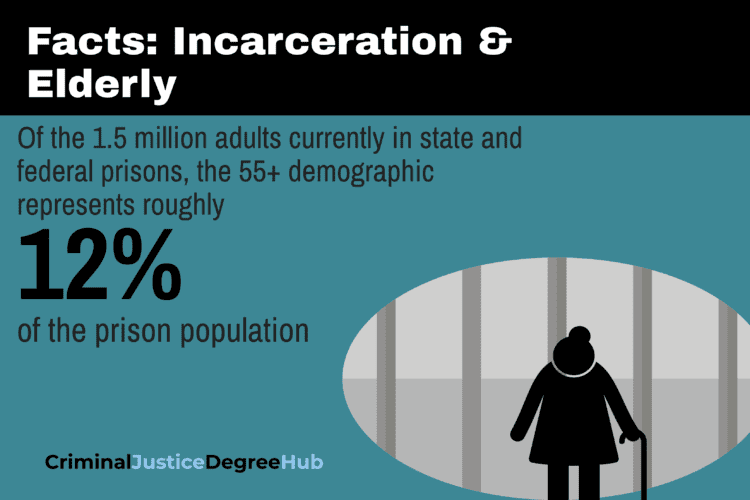Have you ever wondered about The Growing Issue of Elderly Prisoners? Since the early 2000s, the number of elderly inmates has surged at staggering rates. A sampling of elderly prison population data collected between 1981 and 2010 found that federal prisoners over the age of 55 increased from 8,853 to 124,900. By 2030, this number will likely surpass 400,000. Advocates have demanded a critical change within the criminal justice system to decrease the number of elderly convicts behind bars. With new legislature, more geriatric prisoners could qualify for early release programs. The benefits are twofold. The parolee will not spend the rest of his or her life behind bars, and the public experiences less of a tax burden. Caring for an elderly inmate is expensive with annual costs that could surpass $100,000 per prisoner.

Categories of Aging Offenders
There are four main categories of older prisoners. The categories provide the circumstances surrounding the incarceration of a senior offender. The following represent vital facts of the elderly prison population:
Featured Schools
- Older offenders-The age of initial incarceration is at least 50 years old. The sentence length is a minimum of 20 years with a single prison term. In these circumstances, charges levied include murders and sex crimes.
- Young long-term offenders: In these circumstances, sentence lengths vary, but the prisoner is under the age of 50 at the time of his or her first incarceration. The prisoner is serving a first term or has become a repeat offender. Crimes committed involve repeat drug charges, sex crimes, armed robbery, and murder.
- Repeat offenders: Repeat offenders are younger than 50 at the time of initial incarceration. Sentences are more than 20 years, and the prisoner has started on a second term or later. Crimes associated with this category include drug possession, theft, and burglary.
- Young short-term prisoners: In this circumstance, the offender was under the age of 50 during the first term. Sentences are less than 20 years, and this is his or her first time. Charges can include burglary, theft, and drug possession.
Reasons for Increased Prison Populations
By 2030, estimates show the number of elderly prisoners will surpass 400,000. This number represents a 4,400 percent increase from the elderly prison population in 1981. Each year, the total number of geriatric inmates only seems to go higher and higher. Between 2007 and 2010 alone, the number of federal prisoners older than 65 increased at a 94 percent faster rate than all other prison populations. Some states have a much higher senior prison population than others. For instance, Massachusetts, Nevada, and West Virginia have almost double the number of prisoners over the age of 55 compared to North Dakota, Indiana, and Connecticut.
Statistics have demonstrated why so many older adults have gone to prison during their senior years. One reason for the doubling of prison populations is truth in sentencing guidelines and three-strike laws. For starters, truth in sentencing are laws created to curb parole among prison populations. The goal of these guidelines is to ensure prisoners serve the full terms of their sentences without early release. Three strike laws aim to increase the length of sentences for those with two prior convictions. Many of these laws make it very difficult for offenders to receive any punishment less than a life sentence. Based on these laws, the prison population had gone up drastically over the decades from 739,930 in 1990 to 1,543,206 in 2010. Life sentences have quadrupled between 1984 and 2008. In 1984, only 34,000 prisoners in the United States were serving life sentences. In 2008, the number of life sentences stood at 140,610. Also, the number of life sentences without parole tripled from 1992 to 2008 from 12,453 to 41,095.

The Cost of Geriatric Inmates
As a society, we often forget that aging adults in the prison system isn’t merely a corrections problem. As more and more aging offenders end up behind bars, taxpayers become responsible for the billions of dollars needed to keep them incarcerated. Among these costs are a slew of insufficient programs. Programs for the elderly in prison rarely focus on rehabilitation and a reintroduction to society. Also, there is a lack of programs for geriatric offenders that allow for an early release due to compassionate circumstances. Advocates are calling for more early release programs for aging inmates. These programs could allow for conditions that monitor the parolee after his or her release from jail. Conditional release programs are especially useful for geriatric inmates who pose a minimal safety risk. Many programs targeted to elderly prisoners became dismantled over the years. Policymakers need to consider the reauthorization of these grants.
The cost to care for aging offenders is higher than the price to incarcerate those under the age of 55. Aging behind bars means the prisoners face the same physical decline as anyone who grows older. Aging offenders are prone to mobility issues, dementia, and impaired vision and hearing. Elderly prisoners are also more likely to develop medical conditions like cardiovascular disease. Correctional budgets need to provide older prisoners with access to medical care and accommodations. These accommodations could include ramps and specialized housing. It’s also standard that geriatric inmates require medical care outside of a correctional facility. External care costs represent a staggering 72 percent of all prisoner healthcare budgets.
Furthermore, studies show that treating an elderly prisoner with a chronic medical condition costs up to two times more than the national average. The average annual cost associated with an incarcerated individual is $34,125. In comparison, the average price for caring for each member of the elderly prison population is $68,270. However, those with complicated medical issues could cost the system as much as $102,405 each year. Due to this disparity, there’s a call for further expansion of medical parole programs.
A reality is that many of the elderly in prison will die behind bars. On average, more than 3,000 men and women die while incarcerated each year. Due to the trauma and the stress of their incarceration, geriatric prisoners are more prone to serious health issues. Incarceration can lower life expectancy rates with studies showing that prison can shorten lifespans by an average of two years.
Advocacy for Geriatric Prisoners
Compassionate release grants are one of the top ways to lower elderly prisoner rates. These programs help grant early release to those who wish to spend their later years outside of prison. The current legislature for compassionate release is strict with only prisoners with extraordinary and compelling reasons eligible for the programs. State laws vary on the rules of compassionate release, with only a few states designating different provisions for geriatric inmates. For instance, California, Maryland, and Washington are examples of states with geriatric parole programs. Geriatric parole programs are based on age, while compassionate release programs usually grant early release to those who are terminal or seriously ill. Compassionate and geriatric releases are considered on a case by case basis with most states requiring a submitted application to the Bureau of Prisons.

Retractors of compassionate release programs state that elderly prisoners could still pose a threat to society. The fear is that once out of prison, the parolee will then recommit a crime. However, the repeat offender rate for elderly parolees is substantially lower than that of younger parolees. A study of 200 elderly prisoners released early from Maryland found a recidivism rate of just 3 percent. In comparison, the national average for all released prisoners is 66 percent.
Along with compassionate release programs, elderly prisoners should receive funding or aid that helps transition them once out of prison. Finding a place to live or a job can be an impossibility for an older former convict. Programs should be available to help senior parolees find housing in facilities like nursing homes. Funding programs can also confirm that after the senior’s release from prison, they have the monetary means to receive proper healthcare.
Advocacy can start by changing the legislature that increased the prison population in the first place. Policymakers need to consider the consequences of guidelines from three-strike laws. More leniency provides an opportunity for an elderly convict not to die in prison but also promises savings for taxpayers. Instead of life sentences without parole, judges should consider the nature of the crimes and evaluate whether or not the older convict is a threat to society.
Research has found that aging prisoners will have a lasting impact on criminal justice budgets. Costs related to older prisoners’ medical care are substantial and only expected to grow as fewer elderly prisoners qualify for early release. For each elderly inmate released early from their sentences, prisons experience an annual savings upwards of $66,000. Strategies that should be utilized to manage the current problem include conditional releases and compassionate releases. Limited releases apply to those who pose little safety or a flight risk. The parolees must also abide by a set of guidelines to avoid parole violations. Medical parole programs can benefit from an expansion to impact more significant populations. Aging prisoner release programs could also prove profitable to prisons and taxpayers.
Related: